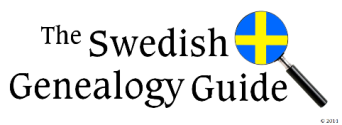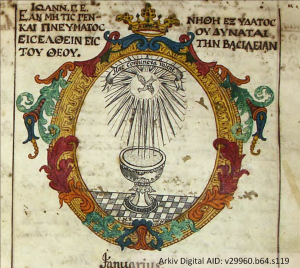Are you looking for the birth information of an ancestor in Sweden? The kingdom of Sweden has some of the most comprehensive records for genealogy in the world. Beginning in 1686 every birth and christening was to be recorded by the local parish regardless of religious affiliation. By law all infants were to be christened within 8 days after birth. An emergency christening could be performed if they thought the child might die before getting to the church.
How do you find a birth / christening date?
1. Choose an online provider to access the Swedish church records. The following providers have birth and christening records online:
Arkiv Digital: http://www.arkivdigital.net/ subscription, free access in a FamilySearch Center, images in color, easy navigation
Riksarkivet SVAR: http://sok.riksarkivet.se/ subscription, images in greyscale from microfilm, easy navigation
FamilySearch: https://familysearch.org/ lds account access, images in greyscale from microfilm, less easy navigation
Ancestry: http://www.ancestry.com/ subscription, images in grayscale from microfilm, less easy navigation
2. After you find the online collection for a parish, choose the record type called Födde or Födelse och dopbok (Birth Record.)
3. Browse to the table of contents and find the page number for the births. Navigate to the desired page.
4. Get used to the format and look for key words (see key words list below.)
5. If you know the date, look for the year, month, and date.
6. If you don’t know the date, search each entry looking for the names of the child, or the parents.
What will you find in Swedish birth / christening records?
Should Include:
- Date of birth (depending how the record was kept)
- Date of christening (depending how the record was kept)
- The first and last name of the father
- The first and last name of the mother (depending how the record was kept)
- The parents place of residence at the time of the birth
- The first and last names and residence of the godparents (who may or may not be related to the child)
May Include:
- Entry number
- The name of the woman who held the infant over the baptismal font
- Date of the mothers re-introduction into society (usually about 6 weeks after the birth)
- The mothers age ( beginning about 1750)
- A running total number of males and females born in a given year
Additional Information
- See the Swedish Genealogy Guide video on Swedish Birth and Christening Records (YouTube)
- There was no standard format of how the record was kept until 1894. Sometimes the father’s name is given and the mother’s was left out. You may find the record shows a christening date but no birth date.
- Birth and christenings were generally kept in the same book as the marriages, and burials. Most of the time there is a specific section of a book. Other times the priest kept an ongoing record of all services (births, marriage, deaths) in a chronological order.
- If you do not find the birth entry:
– Check the birth records of the other parishes in the same pastorat.
– Check the parish accounts book. Usually the father paid a fee at the time of the christening. The fee might be recorded in the donations/income record.
- Swedish archive letter for birth records: C
- The dates were usually recorded in the order of: day, month, year
- Sometimes the christening date was recorded according to the religious “feast day” such as Ascensionis Domini (in latin) or Kristi himmelsfärdsdag (Swedish) which converted to May 9 in 1771. If you need to convert a feast day see: Moveable Feast Day Calendar for: Sweden in the FamilySearch Wiki.
Key Words
Here are some common words that are seen in Swedish birth and christening records. The birth entry will also include the marital status of the parents, place names, and maybe the occupation of the father. If the word is not on this list, try to find it in the Swedish Historical Dictionary Database, SHDD
| Swedish | English |
|---|---|
| absolution | receiving forgiveness of sins |
| af | of, from |
| anteckningar | note, annotation |
| barn (barnet) | child, infant (the child) |
| christnades | (was) baptized, christened |
| dag | day |
| den | that, the |
| dess | possessive of den, det |
| dito | ditto |
| Dom., Dominica (latin) | Sunday (the Lord’s day) |
| dop, döpelse, döpt, döptas, döpte, döptes | various uses of the word “dop” = baptism |
| dopbok | baptismal book (record) |
| dopnamn | christian name |
| dop-vittnen | witness to christening |
| ett, en | one |
| fader, far, faderen | father, sire, (the) father |
| fadder, faddrar, faddrarne | various uses of the word ”fadder” = godparent |
| födas, född, födde, föddes, födelse, födt | various uses of the word ”födelse” = birth |
| församling | parish, congregation |
| föräldrar, föräldrarne | parents |
| heta, heter | to be called |
| Hustru, Hu. | Wife, spouse (abbrev. Hu. ) |
| i | in, at, to, upon |
| kalla, kallat | to call, to name, was called |
| kyrkotagning | churching (received to the parish) |
| kön (man-, qvin-) | sex, gender (male, female) |
| med | with |
| moder, moderen | mother, (the) mother |
| månad | month |
| namn, namnet | name, (the) name |
| nöd-döpt | baptism in case of necessity, or emergency |
| och, ock | and |
| oäkta barn | Illegitimate child, bastard child |
| piga, pigan, pig. | maid, maidservant (abbrev. Pig.) |
| stånd | state, class, rank |
| susceptrix (latin) | person who held the infant over the baptismal font |
| testes (latin) | witness |
| uti | see i |
| vittne, vittnen | witness, (the) witness |
| år, åhr | year |

